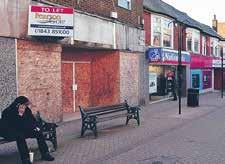Thomas Laskowski, History at St Catherine's College
Giving the High Street a facelift: the case for business rates reform 42
At the end of last month, Shadow Chancellor Anneliese Dodds unveiled a new proposal to grant local councils the power to take possession of long-term empty shops, bring them back into use, and offer them up for rent to local businesses and enterprises. Perhaps unusually among 20-year-olds, the future of the British High Street is a topic close to my heart — my parents own and run a small, independent bookshop. While the leafy, suburban North London street on which it sits has seen comparatively few shuttered shopfronts, in far too many towns and cities up and down the country, the scars left in the aftermath of the 2008 financial crash have not yet begun to heal. In the wake of the Covid-19 pandemic, the future of the retail sector is now more uncertain than ever. Most household name chains are either contracting, or closing their doors for good. With the loss of shops such as these, there is a real danger that the knock-on effects of reduced footfall and falling sales will take their smaller neighbours down with them. If new Conservative changes to planning laws which enable shops to be converted into homes without planning permission — due to come into force later this year — continue unopposed, it is likely that these closures will be irreversible.
More sceptical readers may think that rumours of the death of the High Street have been greatly exaggerated. Retail Tsars like Mary Portas — appointed to undertake an independent review into the future of town centres and high streets back in the hazy Coalition days of 2011 — have been banging on about the need to reimagine the future of shopping in Britain for the better part of the last decade. In the wake of her review, Cameron and Clegg’s government put many of her recommendations into practise, including measures to discourage landlords from leaving shopfronts empty. If the same concerns that Dodds is currently attempting to address were raised almost a decade ago, why has so little been done? It is tempting — and not altogether untrue — to blame Tory apathy and ineptitude for these failings. To do so, however, is to ignore the central problem with both Portas’ and Dodds' proposals: fundamentally, efforts to smarten up shopfronts and give dilapidated town centres a facelift amount to little more than surface-level tinkering which does very little to address the structural problems facing the British retail sector.
If there has been one clear winner from the pandemic, it has undoubtedly been online retailers. Spiralling profits at Amazon — and a rise in quarterly sales of over 40% by July 2020 — made Jeff Bezos the first ever capitalist to break the $200 billion barrier, while poorly-paid warehouse staff across Europe and the US struggled with overcrowded conditions, a lack of proper PPE, and pressure from managers not to take time off for illness. Despite skyrocketing sales, Amazon’s UK tax bill has remained low. One of the reasons for this is the way in which its taxes are calculated. There are two main types of tax on retail businesses in the UK: corporation tax, which is levied on profits, and business rates, a more complex tax based on the rental value of the premises a business occupies, modified by a ‘multiplier’ set by the government, calculated using the Retail Price Index (RPI), and various other factors.













